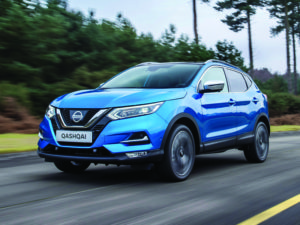Road Test: Nissan Qashqai
The class leader has had a customer-focused update for 2017, explains Alex Grant.
SECTOR Crossover PRICE €20,500-€38,000 FUEL 3.8-5.8l/100km CO2 99-134g/km

The new Nissan Qashqai
Nissan has had such a successful ten years with the Qashqai, that it’s almost hard to imagine the forgettable Almera and Primera filling this car’s role. Practical and fashionable, it holds a more than 10% share of the crossover segment it redefined in Europe, and remains the benchmark product despite a vast choice of alternatives.
Familiarity is a mixed blessing with plenty of reasons to go elsewhere, but Nissan knows this segment better than most. It’s sold 2.3 million Qashqais since 2007, plenty to repeat customers, and says it takes criticisms and praise on board with new models. So what sounds like a subtle update here, is perhaps more impressive than the sum of its parts.
Styling updates – new bumpers, lights and wheels – are the most obvious parts of that process, bringing the Qashqai in line with the Micra. And they’re not only a cosmetic upgrade, the more sculpted lenses and a new under-body panel helping to reduce wind noise, while the aerodynamic 19-inch alloy wheels mean there’s no CO2 penalty for moving into the higher trim levels.
A hatchback-like driving experience has always been among this car’s strong points, though that’s been fine-tuned too. Adjustments to the steering, suspension and chassis components are aimed at better ride and handling characteristics, and a more natural feel to the driving experience. It’s a small enough change that most probably won’t notice; the new Qashqai rides comfortably over rough surfaces, doesn’t roll through corners and feels stable and relaxed at speed. So did the old one.
What is noticeable, though, is a step forward in refinement between the two cars. Extra sound deadening, thicker rear glass and better isolation of engine noise and vibration add up to a much quieter, more refined long-distance car than the old Qashqai. Nissan’s claims of premium-brand aesthetics inside are debatable, but it’s up with the best in the class when it comes to comfort.
That said, the cabin certainly isn’t poorly appointed. The thicker steering wheel is nicer to hold, while the new, more heavily-bolstered, seats fitted from the mid-spec N-Connecta upwards are excellent. For the full premium-brand experience, the new top-spec Tekna+ trim also has watchstrap-style leather seats and additional fabric trim on the most-touched parts of the doors.
The Qashqai broke new ground in 2014, with CO2 emissions of 99g/km for the most fleet-relevant 110hp, 1.5-litre diesel engine, and its sister car, the Renault Kadjar, is the only competitor to match that figure since. It’s a quiet engine with plenty of pulling power at low revs, though there’s a much wider spread of performance in the 130hp 1.6-litre diesel. And, at 116g/km and 4.4l/100km, that’s still a relevant choice for fleets.
As is the ProPilot system arriving later this year, which will manage steering, braking and acceleration on the highway. Small details, but they add up to a package good enough to keep Nissan at the top of its class.
What we think
Competition is fierce in this segment, but this remains the car to beat. A wider choice of trim levels also means it can aim for the premium brands, as well as its direct rivals.

